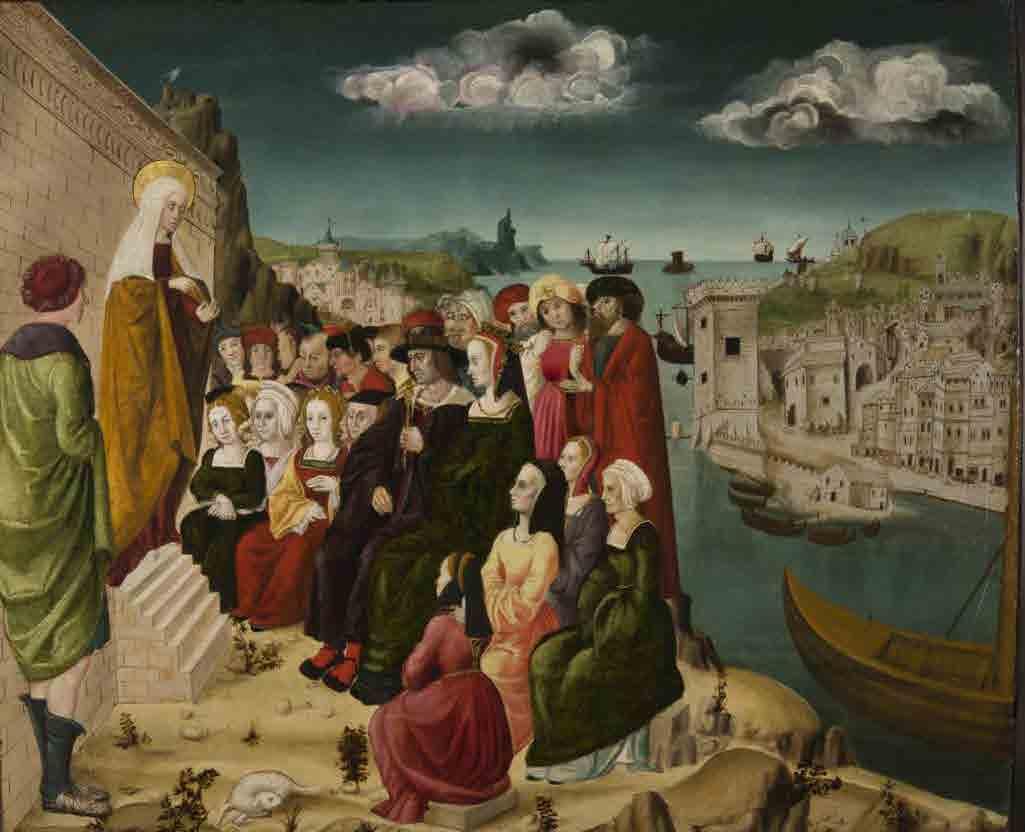
4 minute read
St Mary Magdalene preaching in Marseilles
By a follower of Antoine de Ronzen, c. 1513 Paris, Musée de Cluny
By Caroline Shaw
In this beautifully detailed panel by a Provençal artist, we see an unusual image of St Mary Magdalene, standing on a raised platform, addressing a crowd that is seated near a wide stretch of water with a city on the opposite shore. Her yellow-gold robe might remind us of her former extravagance and wealth, but we soon notice that instead of a voluptuous silken dress and long golden hair, her head is covered by a white veil, and her undergarment is dark and modest. She has a solemn, concentrated look on her face as she speaks, and her hand gestures emphasize each point that she makes. We can imagine her clear beautiful voice ringing out across the bay as her listeners sit, attentively absorbing what she is saying.
This is not a scene that most of us are used to seeing. In Western art, we know St Mary Magdalene from the Gospel stories: as the beautiful fallen woman who washes Our Lord’s feet with her tears at the house of Simon the Pharisee; as the mourner weeping at the foot of the Cross, sharing Jesus’ passion with enormous anguish and pain, or soon afterwards, as the first witness to the Resurrection, tentatively reaching out to Our Lord at dawn in the garden.
In this image however, we see a different and lesser-known aspect to the life of this great saint, whose feast we commemorate on 22 July. It is one that is not mentioned in the Gospels, but which we know through Tradition. This painting shows us what happened to St Mary Magdalene after the Passion and Resurrection of Our Lord. Officially speaking, she disappears, since she is not mentioned in the Acts of the Apostles. However, an ancient tradition tells us that fourteen years after the Resurrection, she and a large group of disciples – seventy-two in all – were herded onto a boat by the Jewish authorities, who were determined to expel all Christians from Judea.
This ship - whose passengers included Mary Magdalene’s brother Lazarus, her sister Martha, and Maximin, a disciple to whom St Peter had entrusted the care of St Mary Magdalene – was deliberately denied a rudder and a pilot, and sent out to sea in the expectation that they should all be drowned. By God’s providence, the disciples did not perish, but landed safely on the shores of southern France, at the port-city of Marseilles. It is this city that we see here: in fact, this is the first known depiction of Marseilles in Western art. In the bottom right-hand corner is the wooden barque in which they had sailed.
At first, the disciples had nowhere to go. The pagans of the city would not give them shelter, so they rested beneath the portico of a popular pagan shrine, whose outer wall we see on the left. When St Mary Magdalene saw the people gathering at the shrine to offer sacrifices, she was moved to preach the truth of Christ crucified to them, and exhorted them to give up their cult of idols. ‘All who heard her,’ wrote Jacobus de Voraigne in his 13th century account of her life, ‘were in admiration at her beauty, her eloquence and the sweetness of her message’. A few days later, the governor of the province came with his wife to offer sacrifices at the shrine, and in particular to petition the gods for a child, since they could not conceive. St Mary Magdalene preached the message of Christ to them, and managed to dissuade them from offering sacrifices. They returned several times afterwards to listen to her speak.
This is the scene that the painter has depicted. The governor and his wife are seated in the centre of the group of listeners, raised up a little on a makeshift seat on the rocks. The governor, with his red hose and his solemn expression, is thought to be a likeness of René of Anjou, the Count of Provence, who was reigning at the time of the painting, while his dignified, melancholy-looking wife is a likeness of René’s second wife, Jeanne de Laval. The retinue surrounding them, perched rather uncomfortably on the rocky outcrop, are all members of the court, richly dressed in silks and velvets with elaborate head-dresses. St Mary Magdalene’s preaching touched their hearts: the governor and his wife were converted, and soon afterwards they conceived a son.

‘… here we see her communicating with great eloquence and beauty the message of Christ, commanding the attention of pagan nobles in a distant land, and exhorting them to conversion. Filled with the Holy Spirit, she is truly Rubens’ ‘Descent from the Cross’ is considered to be one of the greatest paintings of the 17th century. an Apostle of Our Lord’
After several years, St Mary Magdalene retired to a cave high up in the mountains of Provence, where she spent the last thirty years of her life in continual prayer and fasting, supported by angelic attendants and lifted high by ecstatic visions. This is the period of her life that inspired so many Counter-Reformation artists, who often depicted her dressed in rags, seated on a rock in a dark cave, her long hair straggly and unkempt, her dress torn and her face stained with tears - the perfect symbol of penitence.
This obscure but rather beautiful painting from Provence reminds us of a little-known aspect of St Mary Magdalene’s life, and thus increases our knowledge of her in a rather wonderful way: here we see her communicating with great eloquence and beauty the message of Christ, commanding the attention of pagan nobles in a distant land, and exhorting them to conversion. Filled with the Holy Spirit, she is truly an Apostle of Our Lord.











